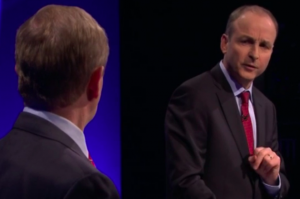
If the polls are to be believed, Fine Gael and Fianna Fáil would appear to be the only potential coalition that could be formed after February 26th. Will a historic sword finally fall?
One fails to see how such a sequence of events would be, to coin the phrase, in the national interest and I cannot see how anyone could view this in positive terms.
But those in the know were whispering of such a notion long before last Wednesday’s Red C poll.
The first time the prospect of another election was mentioned to me came over a half-time cup of tea (plus the requisite ham sandwich) in Fraher Field towards the end of last summer.
A battle-hardened Fianna Fáiler from the west of the county suggested that a Fine Gael/Fianna Fáil coalition would “end in tears,” adding: “they might get as far as one budget together…but it’d all fall apart after that”.
To say he wasn’t keen on the idea was something of an understatement before we got back to talking about something that really matters – the GAA, in case readers were curious!
Less than an hour after UCC’s Theresa Reidy told RTE’s ‘Late Debate’ that a second election within a few months of Friday week’s election could well be in play, WIT law lecturer Dr Jennifer Kavanagh dropped me a potentially telling line.
“All RTE background reports are being done without mentioning the year as they think they’ll be used a few times in the next few years,” Dr Kavanagh disclosed on Wednesday last. “When I took part in a few podcasts along with Noel Whelan, we were told to be year neutral.”
The notion of a second election, harking back to the 1981-82 period when three campaigns were waged inside 18 months, cannot be welcomed by anybody.
But given that election time is always a period in which we should expect the unexpected (remember when Sean Gallagher was a dead cert for the Presidency?), the Red C poll that got us all jittery last week may prove somewhat (but probably not considerably) different come the final analysis.
Since we the people elect the Dáil while the Dáil in turn elects the government, all that we the people can hope for is that those with the power – and the numbers – do a deal, form a coalition and put the people first.
And this is why pre-election vows by party leaders about they will and will not go into government with has become my largest single source of pre-election frustration.
In our PRSTV system, to have Fine Gael and Fianna Fáil, the Collins/Dev or Press/Indo parties as they’d once have been hailed, more concerned by optics than the reality of what we’re probably just a fortnight away from facing, borders on the infantile.
Consider the following scenario come February 26th: Fine Gael winning 57 seats and Fianna Fail taking 40 seats – figures which are both at the higher end of what either are likely to win. That a two party bloc in and around the 90 seat mark would not sit down and do business together is utterly illogical.
No Government would feel too safe were it to enter the 32nd Dáil with a wafer thin majority of, say, 80 or 81 seats (the magic number is 79).
Any sensible negotiators would have to make allowance for at least three defections during the lifetime of a parliament which would surely suggest that a two party administration would have to command, at a minimum, a majority of seven from day one.
However, the rump of Labour, support from Renua or the Social Democrats or independents from either the FG or FF gene pool cannot be ruled out, but repeated polls would still suggest the logic of a FG/FF coalition.
“Apart from the old Civil War wounds and Blueshirts and Soldiers of Destiny turning in graves, is this really such an appalling vista?,” former PD TD Liz O’Donnell queried in her Paddy Power blog.
“Is a hung Dáil preferable? Or a collage of independents and small parties? I think not. There is a duty on political leaders to honour the people’s vote in elections and form a government which reflects their considered choice. Des O’Malley buried the hatchet with his arch enemy Charles J Haughey and broke the mould of Irish politics by going into coalition with FF in 1989. Nobody died and the rest is history.”
Younger voters probably have no idea just how much Haughey and O’Malley detested each other. Yet still they governed together, an utterly improbable notion when Haughey expelled O’Malley from Fianna Fáil in 1985, catalysing the creation of the Progressive Democrats.
Enda Kenny might detest Gerry Adams’ association with the IRA, but I don’t think anyone could suggest he personally despises the Sinn Féin leader.
Of course Mr Kenny also has his differences with Micheál Martin but I feel it’s clear that the only venom that either man might spit at each other across the Dáil floor is purely political.
It is quite remarkable to consider that Ian Paisley and Martin McGuinness, granted, via the D’Hondt system, broke bread together in Northern Ireland before Fine Gael and Fianna Fáil have done likewise in the Republic.
So will Fianna Fáil cede the opposition platform to an upbeat Sinn Féin in the 32nd Dáil (a move which, in Senator Averil Power’s view, would finish off FF), cross the aisle and end civil war politics by coalescing with Fine Gael? If the post-election numbers dictate it, at the very least, they’ll have to consider it, possibly under a new leader. Stability or chaos? The national interest? Hmm…

